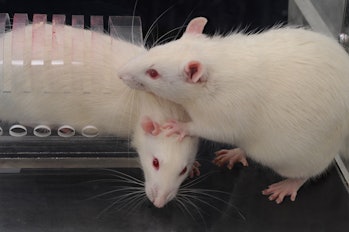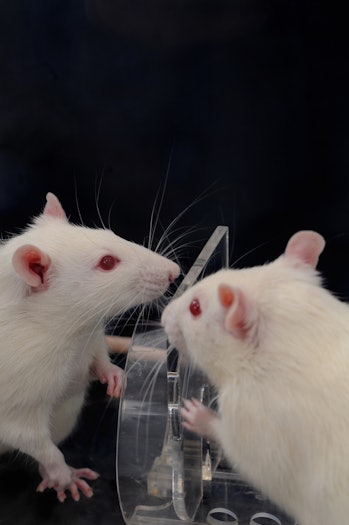Rats behave oddly like humans when they see a peer in distress.
NINA PULLANO JULY 8,2020
When people see others in distress, the decision about whether or not to step in and help is heavily influenced by whether or not other people are present. This idea underlies the social psychology theory known as the "bystander effect." It posits that the more people there are, the less likely a victim is to receive help.
In new research conducted in rats, scientists observed the bystander effect. This marks the first time the phenomenon has been seen in non-human animals — and possibly upends previous beliefs about why the effect even exists.
The most basic principle of the bystander effect is this: When a person is part of a group, they're less likely to help someone in need than if they're alone. The reason why humans behave this way is often explained by a diffusion of responsibility — with a larger group, people might feel less personally responsible for helping.
Researchers set up a rat experiment and found that these animals are also more likely to help a struggling peer when they're alone, compared to when they are in a group. They also discovered that the behavior of the group — namely, others' willingness to help — played a key role in whether or not an individual would step in.
This finding was published Wednesday in the journal Science Advances.
Peggy Mason is a neurobiologist at the University of Chicago and the lead study author. She argues that this finding suggests that humans are not actively weighing the pros and cons when deciding whether or not they are going to offer help. Instead, they are responding to biological instincts — just like the rats.
"This is not a human cultural phenomenon," Mason says. "This is part of our mammalian inheritance."
TESTING FOR THE BYSTANDER EFFECT — The bystander effect in both humans and rats hinges on how other the overall group behaves.
To test this in rats, Mason's team restrained one rat using a small device. Then, the researchers tested other rats to see how they would respond based on the behavior of others.
To create a group of rats that would not be likely to help the trapped rat, the researchers gave some of the rats categorized as "bystanders" an anti-anxiety drug similar to Valium. This was the researchers' way of ensuring that these rats would not help the rat in distress. The goal was to see whether or not a rat not on drugs would still jump in and help the rat in distress, despite guaranteed inactive bystanders.
Subsequently, the experiment revealed that when bystanders were unhelpful, rats were less likely to help the restrained rat.
"IT’S THE INDIFFERENCE OF THESE OTHER RATS THAT CHANGES THE EXPERIENCE FOR THEM."
Interestingly, rats surrounded by unhelpful bystanders weren't always dissuaded from helping. Many of them tried to help the restrained rat on the first day of the experiment. But the indifference of the other rats meant the helper didn't get any positive reinforcement for its work, and on subsequent days, the initially helpful rats did not attempt to provide aid again.
"It’s the indifference of these other rats that changes the experience for them," Mason says.
When rats were tested alone, the bystanders who had not helped at all before — and who were no longer drugged — offered aid.
But strangely, the rats who did help the restrained rat in a group, and were then tested alone, often stopped opening up the door. "They lost their audience," Mason says.

Rat helps a struggling peer.David Christopher, University of Chicago
BYSTANDER BACKGROUND — Ironically, the body of research underlying this study was inspired by a real-life example that turned out to be mostly untrue.
In 1964, newspapers originally reported that 38 neighbors watched as a woman named Kitty Genovese was murdered, over a 30-minute timespan. This report of a large group of bystanders turned out to be false, but shock elicited by reporting at the time motivated researchers to study how people behave when others are in trouble.
The bystander effect was first described in a 1968 paper. Importantly, the people in that 1968 experiment were hired by the researchers and told not to intervene, making them "confederates" — like the rats dosed with anti-anxiety medication.
While the narrative that prompted research was false, the bystander effect has been confirmed in a number of studies — although our understanding of it has become more nuanced over time. For years, the prevalent idea was that everyone experiences bystander apathy to a similar extent. Now, some scientists think bystander reactions are different because our brains process emergencies differently.
THE BIG PICTURE — These new findings could help to explain human behavior in a broader cultural context. Chilling videos of police brutality, including the murder of George Floyd, often include bystander officers neglecting to step in, while nearby civilians do attempt to help.
Police are "confederates by training," Mason explains. "They're taught not to intervene."
Conversely, the civilians who do try to help — as they did when George Floyd was killed — are untrained, like the unimpaired subjects of the rat experiment.
"Not only does this show something about the fundamental basis of an important part of our behavior," Mason says, "but it also tells you that this is going on all the time in our real lives."

This is the first time the bystander effect has been observed in a non-human animal.David Christopher, University of Chicago
Put together, analysis suggests that police violence is not a situation wrought by "bad apples," Mason says. Instead, it is a result of a complicated mix: The biologically-based bystander effect, and a police system that encourages confederate bystanders on top of that.
“We have to toss out this bad apple explanation,” Mason says. "What we have is a systemic, institutionalized problem."
Abstract: To investigate whether the classic bystander effect is unique to humans, the effect of bystanders on rat helping was studied. In the presence of rats rendered incompetent to help through pharmacological treatment, rats were less likely to help due to a reduction in reinforcement rather than to a lack of initial interest. Only incompetent helpers of a strain familiar to the helper rat exerted a detrimental effect on helping; rats helped at near control levels in the presence of incompetent helpers from an unfamiliar strain. Duos and trios of potential helper rats helped at superadditive rates, demonstrating that rats act nonindependently with helping facilitated by the presence of competent-to-help bystanders. Furthermore, helping was facilitated in rats that had previously observed other rats’ helping and were then tested individually. In sum, the influence of bystanders on helping behavior in rats features characteristics that closely resemble those observed in humans.
No comments:
Post a Comment